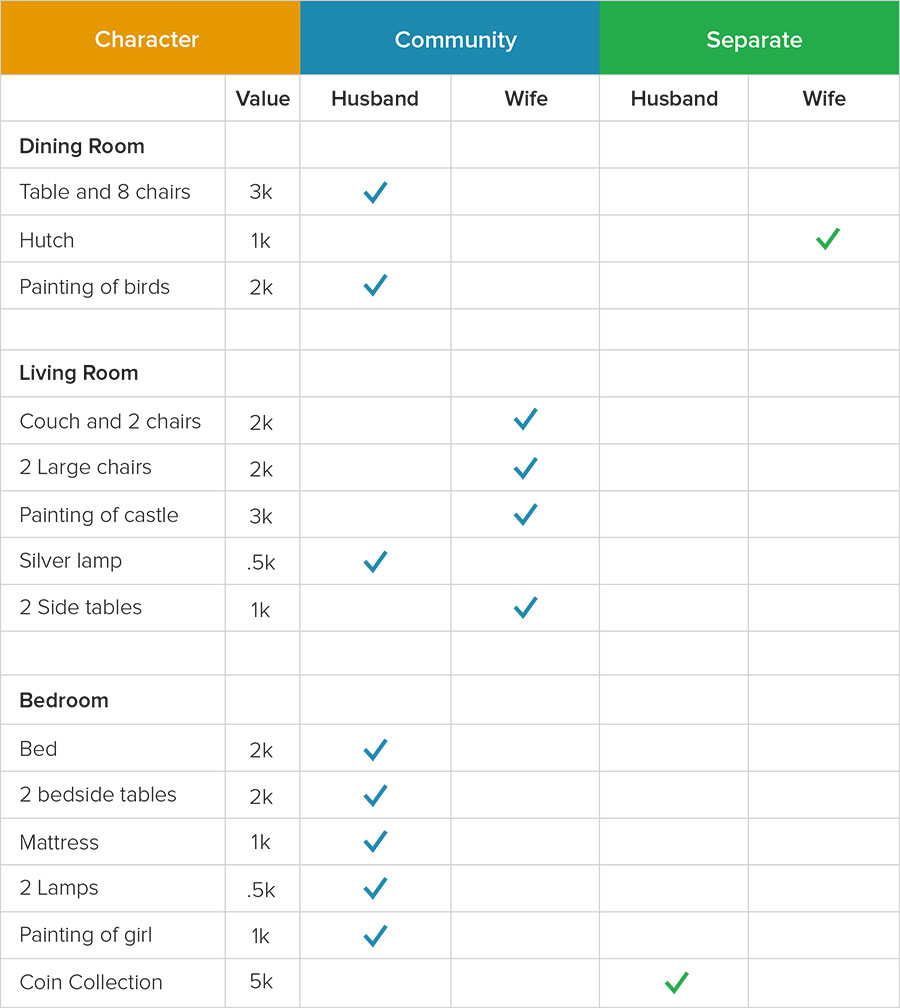Characterization And Division of Furniture And Furnishings
How Are Furniture And Furnishings Divided In A Divorce?
Family law courts are reluctant to spend their limited time and resources dividing furniture and furnishings. Courts are impacted due to budget constraints and simply do not have the resources to address these issues. Parties usually know the relative value (garage sale prices are generally used) of their furniture and furnishings and which items they value more than others. Generally, parties are able to agree upon a division of these items without the assistance of counsel or appraisers.
Example: Division Of Furniture And Furnishings Inventory
Preparing an inventory of furniture, furnishings and collectibles, organized room by room before moving out of the house, is important. A videotape and/or photographs of the items may be helpful in the division of these items during the divorce process.

Procedures And Solutions
After consulting with a lawyer and understanding the relevant issues, it is generally cost-effective for the parties to attempt to divide the furniture and furnishings between themselves.
Methods Of Division
Parties may utilize the “coin-flip alternate selection” method to divide these assets. The winner of the coin-flip makes the first selection. The parties rotate selections until the division is complete. The selections can be made item by item or room by room.
One or both parties may not believe that an “alternate selection” is equitable if one particular item is significantly more valuable than any other single item. Items of significant value may be addressed separately.
Alternatively, the selection may proceed with one party receiving the first item, the other party receiving the next two items, and the remaining items being selected on an alternate selection basis.
Alternatively, the parties may agree to appraise the most significant item or items and divide the other items on an alternate selection basis.
If the parties are unable to divide the items between themselves, there are other ways to divide the furniture and furnishings:
Special Masters
- A “special master” is a lawyer or another professional appointed by the divorce court to assist with the division. Generally, the parties’ lawyers are not present during a special master proceeding. The special master, with input from the parties, makes recommendations to the court regarding characterization, valuation and division of the items of personal property. These recommendations are generally accepted and incorporated by the court into a supplemental judgment on reserve issues.
Appraisers
- Appraisers are commonly used to value antiques, art, collectibles and other valuable items. The parties may use the appraised values to:
- Buy or sell all of the items from/to the other party
- Divide the items based on value
- Establish values for a sale to a third party or at an auction
Early Division
Often parties wait until the end of the case to address the division of these items. It may make economic sense to attempt to divide these items early in the process and avoid involving the related attorney’s fees.
Physical Possession
At the conclusion of the case, a judgment is filed with the court that awards each asset to one party or the other. If the furniture, furnishings, collectibles, antiques, art and personal effects have not been physically divided, the judgment should specifically itemize in detail each item being awarded to each person.
Rather than itemizing each item in the judgment, the better approach is for each person to have physical possession of the items he or she is being awarded. This approach also eliminates the conflict that may exist if, after the judgment is entered, one of the parties claims that an item is missing, damaged, etc.